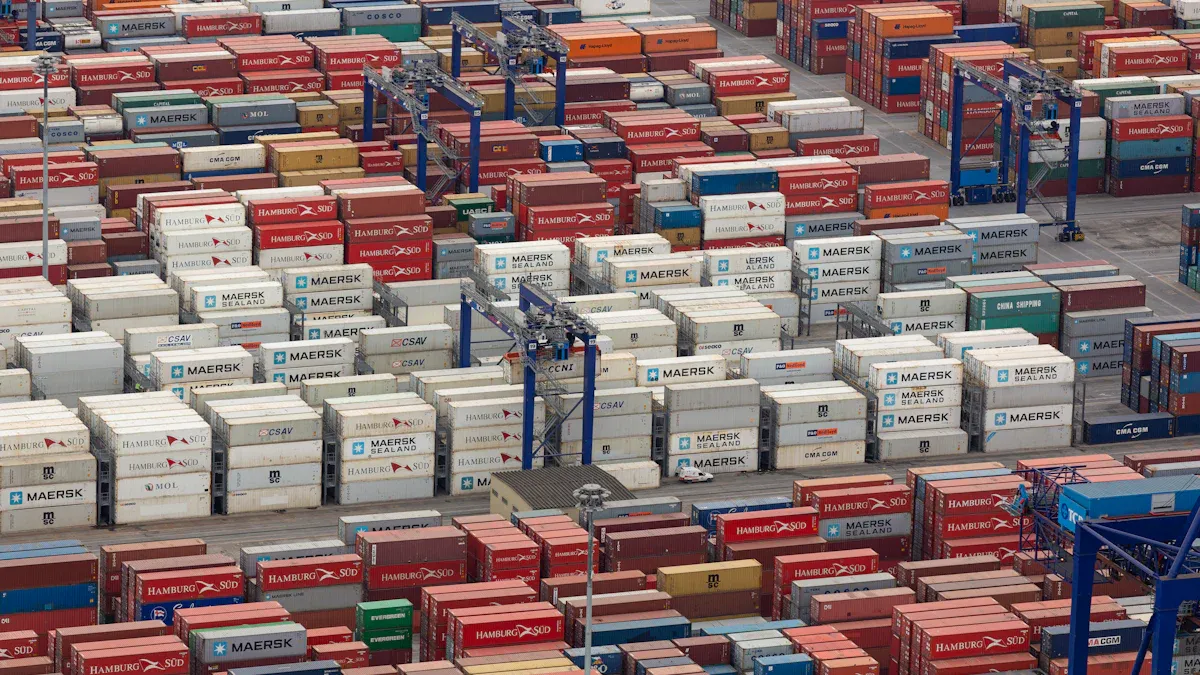Cargo Stranded for Half a Year with No One in Charge? On-Site Tips to Spot Fake Busyness in Warehouse Management!

Inefficiencies in warehouse management can have costly consequences. Cargo stranded for months disrupts supply chains and hampers business operations. From January to November 2021, delays outside the ports of Los Angeles and Long Beach affected $238 billion worth of cargo. In another instance, the Ever Given container ship blocked the Suez Canal for six days, holding up $9.6 billion in daily commerce. These examples highlight how poor management leads to delays and financial losses. Proactive measures are essential to combat fake busyness and improve operational efficiency.
Identifying Fake Busyness in Warehouses

Monitoring Task Redundancy and Inefficiencies
Warehouse operations often suffer from task redundancy, which creates an illusion of busyness while reducing overall efficiency. Managers should evaluate whether employees are performing tasks that add no value to the workflow. For example, repetitive manual data entry or unnecessary double-checking of already verified inventory can waste valuable time. Identifying these inefficiencies requires a systematic approach.
Key areas to monitor include:
Repetitive Processes: Tasks such as scanning the same item multiple times or rechecking completed orders.
Idle Equipment: Forklifts or conveyor belts left unused during peak hours.
Unnecessary Movements: Employees walking long distances due to poor layout planning.
Tip: Conduct regular process reviews to identify redundant steps. Streamlining workflows can significantly reduce wasted effort and improve productivity.
Analyzing Productivity Metrics in Real-Time
Real-time productivity metrics provide valuable insights into warehouse performance. By tracking these metrics, managers can identify bottlenecks and areas requiring immediate attention. JUSDA warehouses leverage advanced systems like eVMI and JusLink to monitor operations and ensure transparency.
The following table highlights key metrics used to gauge operational efficiency:
Metric | Description |
|---|---|
Warehouse Capacity Utilization | Measures how much of the warehouse's total capacity is being used. |
Inventory Accuracy | Assesses the accuracy of inventory records compared to actual stock. |
Shipped Order Accuracy | Evaluates the correctness of orders shipped to customers. |
Dock to Stock | Tracks the time taken for goods to move from the receiving dock to storage. |
On time, in full (OTIF) | Measures the percentage of orders delivered on time and in full. |
Order Processing Time | The time taken to process an order from receipt to shipment. |
Inventory Shrinkage Rate | Monitors the loss of inventory due to theft, damage, or errors. |
Order Fill Rate | The percentage of customer orders that are filled completely. |
Employee Turnover Rate | Tracks the rate at which employees leave the warehouse. |
Warehouse and DC Cost as a Percentage of Sales | Evaluates the cost efficiency of the warehouse operations relative to sales. |
Total Recordable Incident Rate (TRIR) | Measures the safety performance of the warehouse operations. |
Energy Usage / Waste Carbon Emissions | Assesses the environmental impact of warehouse operations. |
Note: Metrics like "Dock to Stock" and "Order Processing Time" directly reflect the efficiency of inbound and outbound operations. Regularly analyzing these figures helps pinpoint inefficiencies.
Observing Employee Behavior and Workflow Patterns
Employee behavior often reveals hidden inefficiencies in warehouse workflows. Managers should observe how workers interact with tasks, equipment, and each other. Behavioral indicators such as under-performance or over-performance can signal deeper issues.
The table below outlines common behavioral indicators linked to inefficiencies:
Indicator Type | Description |
|---|---|
Under-performance | Output delays average > 44.61 seconds |
Over-performance | Number of pieces taken to the buffer > 11.75 units |
Intra-worker performance | High incidences but many valid pieces created |
Inter-worker performance | Higher daily tasks and manufacturing time compared to others |
For instance, under-performance may result from unclear instructions or inadequate training. Conversely, over-performance, such as excessive buffering, can disrupt downstream processes. Managers should also assess intra-worker and inter-worker performance to ensure balanced workloads.
Tip: Use real-time tracking tools like JusLink to monitor workflow patterns. This enables managers to address inefficiencies promptly and maintain smooth operations.
Spotting Signs of Poor Communication and Misaligned Priorities
Poor communication and misaligned priorities often create the illusion of busyness in warehouse operations. These issues disrupt workflows, hinder decision-making, and lead to inefficiencies that can leave cargo stranded for extended periods. Identifying these signs early is crucial for maintaining operational efficiency.
Key Indicators of Poor Communication
Warehouse teams rely on seamless communication to ensure smooth operations. However, breakdowns in communication can lead to confusion and delays. Managers should watch for the following signs:
Frequent Misunderstandings: Employees often misinterpret instructions or fail to follow standard operating procedures.
Delayed Responses: Critical updates or decisions take longer than necessary to reach the relevant teams.
Inconsistent Messaging: Different departments receive conflicting information, leading to errors in execution.
Lack of Feedback Loops: Employees hesitate to report issues or provide feedback, resulting in unresolved problems.
Tip: Establishing clear communication channels, such as daily briefings or digital collaboration tools, can help address these issues. Platforms like JusLink enable real-time updates and foster transparency across teams.
The Impact of Misaligned Priorities
When priorities between departments or leadership levels do not align, warehouse operations suffer. This misalignment often stems from a disconnect between technical teams and business leaders. Common consequences include:
Inefficiencies and underutilization of advanced technologies.
Misaligned investments that fail to address operational needs.
Strategic decisions made without considering technical implications, leading to unforeseen challenges.
Conflicting goals and expectations between IT departments and business leaders.
For example, a warehouse may invest in an advanced inventory management system like eVMI but fail to train staff adequately. This results in underutilization of the system and continued reliance on manual processes, creating inefficiencies.
Practical Steps to Address These Issues
To combat poor communication and misaligned priorities, warehouse managers should implement the following strategies:
Define Clear Objectives: Align departmental goals with the overall business strategy to ensure everyone works toward the same outcomes.
Promote Cross-Department Collaboration: Encourage regular meetings between IT teams, warehouse staff, and business leaders to discuss challenges and align priorities.
Invest in Training: Equip employees with the skills needed to utilize advanced technologies effectively.
Leverage Technology for Transparency: Use tools like JusLink to provide real-time visibility into operations, ensuring all stakeholders stay informed.
Note: Addressing these issues requires a proactive approach. Regular audits and feedback sessions can help identify and resolve communication gaps before they escalate.
By recognizing the signs of poor communication and misaligned priorities, warehouse managers can eliminate fake busyness and create a more efficient, results-driven environment. This not only prevents cargo from being stranded but also enhances overall operational performance.
Practical Strategies to Address Fake Busyness
Implementing Clear Accountability Systems in JUSDA Warehouses
Accountability forms the backbone of efficient warehouse management. Establishing clear accountability systems ensures that every team member understands their role and responsibilities. This clarity minimizes confusion and aligns individual efforts with organizational objectives. In JUSDA warehouses, implementing visible Key Performance Indicators (KPIs) has proven to be a game-changer. These KPIs provide measurable benchmarks, enabling employees to track their progress and identify areas for improvement.
Clear accountability systems have demonstrated remarkable results across industries. For instance:
Retail Distribution Center: Wave pick optimization reduced the distance traveled by 65-70%, significantly boosting processing capacity.
eCommerce with Automated Picking: Addressing congestion issues led to a 50% reduction in congestion and a 30% improvement in Units Per Hour.
Multi-channel Retail Distribution: Optimized picking batches reduced aisle visits by 81.8%, increasing throughput capacity.
These examples highlight how accountability drives operational efficiency. When employees see their performance metrics, they actively work to meet goals and improve processes. This proactive approach fosters a culture of responsibility and continuous improvement.
Tip: Use tools like JusLink to display real-time KPIs. This transparency motivates employees and ensures alignment with organizational priorities.
Fostering a Results-Oriented Culture in Warehouse Teams
A results-oriented culture shifts the focus from activity to outcomes. In warehouses, this approach eliminates fake busyness by prioritizing efficiency and measurable achievements. Managers play a crucial role in fostering this culture by setting clear expectations and rewarding performance based on results rather than effort.
To cultivate a results-driven environment, consider the following strategies:
Define Success Metrics: Establish specific, measurable goals for each team and individual.
Encourage Ownership: Empower employees to take responsibility for their tasks and outcomes.
Recognize Achievements: Celebrate milestones and reward high performers to reinforce positive behavior.
Promote Collaboration: Facilitate teamwork to achieve shared objectives and improve overall efficiency.
JUSDA warehouses exemplify this culture by leveraging advanced systems like eVMI and JusLink. These tools provide real-time insights into operations, enabling teams to focus on achieving key performance metrics. By aligning individual efforts with organizational goals, JUSDA ensures that every team member contributes to the warehouse's success.
Note: A results-oriented culture not only improves efficiency but also enhances employee satisfaction. Workers feel more engaged when their contributions are recognized and valued.
Providing Training for Effective Time and Task Management
Training programs are essential for equipping employees with the skills needed to manage their time and tasks effectively. In warehouses, where operations are fast-paced and complex, proper training can significantly enhance productivity and safety. JUSDA prioritizes ongoing training to ensure its workforce adapts to evolving challenges and technologies.
Effective training programs offer several benefits:
Optimization of space utilization and adherence to standard operating procedures.
Increased productivity through the identification and resolution of workflow bottlenecks.
Data-driven training approaches further enhance these outcomes. By assessing workers' training needs and gaps, managers can customize content and delivery methods. Monitoring the impact of these programs ensures continuous improvement in workforce skills and motivation.
For example, JUSDA uses real-time data from systems like JusLink to identify inefficiencies and tailor training accordingly. This approach streamlines processes, reduces operational costs, and boosts employee engagement. Enhanced skills translate into better customer satisfaction, as employees can handle tasks more efficiently and accurately.

JUSDA Solutions
To provide you with professional solutions and quotations.
Tip: Regularly evaluate training programs to ensure they address current challenges. Incorporate feedback from employees to make the sessions more relevant and impactful.
By implementing these practical strategies, warehouse managers can eliminate fake busyness and create a more efficient, results-driven environment. These measures not only prevent cargo from being stranded but also enhance overall operational performance, ensuring long-term success.
Conducting Regular Audits to Eliminate Inefficiencies
Regular audits play a pivotal role in identifying and eliminating inefficiencies within warehouse operations. These audits provide a structured approach to evaluate processes, uncover hidden bottlenecks, and ensure that resources are utilized effectively. By conducting systematic reviews, warehouse managers can maintain operational excellence and prevent cargo from being stranded.
Key Objectives of Warehouse Audits
Warehouse audits aim to achieve several critical objectives that directly impact efficiency and productivity. These include:
Identifying Non-Value-Adding Activities: Audits help pinpoint tasks that do not contribute to the overall workflow, such as redundant data entry or unnecessary manual checks.
Enhancing Process Accuracy: Regular evaluations ensure that processes like inventory tracking and order fulfillment are performed with precision.
Reducing Waste: Audits focus on eliminating waste in operations, including time, space, and labor inefficiencies.
Promoting Continuous Improvement: By empowering staff to make incremental changes, audits foster a culture of ongoing enhancement.
Tip: Establish a clear audit schedule and involve cross-functional teams to gain diverse perspectives on operational challenges.
Proven Audit Methodologies for Warehousing Operations
Several methodologies have been validated to improve warehouse efficiency. These approaches emphasize waste reduction, process optimization, and the integration of technology:
Lean Warehousing Principles: This methodology focuses on identifying and eliminating non-value-adding activities. For example, streamlining the receipt and order entry processes can save time and improve accuracy.
Automation Reviews: Evaluating manual processes for automation opportunities can significantly reduce errors and enhance productivity. Automating tasks like inventory updates and order processing minimizes human intervention and accelerates workflows.
Continuous Improvement Audits: These audits encourage employees to suggest incremental changes that enhance efficiency. Empowering staff to participate in the audit process fosters accountability and innovation.
Note: Lean warehousing principles emphasize waste reduction as a core strategy. Managers should prioritize evaluating processes for unnecessary steps and implement automation where feasible.
Steps to Conduct Effective Warehouse Audits
To maximize the benefits of audits, managers should follow a structured approach. The following steps outline an effective audit process:
Define Audit Goals: Clearly outline the objectives of the audit, such as improving inventory accuracy or reducing order processing time.
Gather Data: Use tools like JusLink to collect real-time data on warehouse operations. Metrics such as "Dock to Stock" and "Order Fill Rate" provide valuable insights.
Evaluate Processes: Analyze workflows to identify inefficiencies. For instance, review the method of receipt and order entry to uncover gaps and opportunities for automation.
Engage Employees: Involve warehouse staff in the audit process to gain practical insights and encourage buy-in for proposed changes.
Implement Recommendations: Develop an action plan based on audit findings. Prioritize changes that offer the highest impact on efficiency.
Monitor Progress: Track the outcomes of implemented changes using performance metrics. Regularly review these metrics to ensure sustained improvements.
Callout: Automation of receipt and order entry processes has been shown to save time and improve accuracy. Consider integrating advanced systems like eVMI to streamline these tasks.
Benefits of Regular Audits
Conducting regular audits delivers numerous benefits that enhance warehouse performance. These include:
Cost Savings: Identifying and eliminating waste reduces operational expenses.
Improved Quality: Audits ensure that processes meet high standards, minimizing errors and delays.
Enhanced Employee Engagement: Involving staff in audits fosters a sense of ownership and accountability.
Increased Transparency: Real-time tracking tools like JusLink provide visibility into operations, enabling informed decision-making.
By implementing regular audits, warehouse managers can create a culture of continuous improvement. This proactive approach not only eliminates inefficiencies but also ensures that operations remain agile and responsive to changing demands.
How JUSDA's Warehousing Solutions Prevent Cargo Stranded Issues

Advanced Inventory Management with eVMI and JusLink
JUSDA's warehousing solutions leverage advanced inventory management systems like eVMI and JusLink to prevent operational bottlenecks. These systems provide real-time visibility into inventory levels, enabling precise demand forecasting and efficient stock replenishment. By integrating these technologies, warehouses can maintain optimal stock levels, reducing the risk of overstocking or stockouts.
eVMI enhances collaboration between suppliers and buyers by sharing real-time data, ensuring seamless inventory flow. JusLink, on the other hand, offers a centralized platform for tracking inventory across multiple locations. This integration minimizes manual errors and accelerates decision-making processes. Together, these systems streamline operations, ensuring that cargo moves efficiently through the supply chain without unnecessary delays.
Tip: Warehouses using eVMI and JusLink experience improved inventory accuracy, which directly reduces the likelihood of cargo stranded due to mismanagement.
Real-Time Tracking and Control for Proactive Management
Real-time tracking and control are critical for proactive warehouse management. JUSDA employs cutting-edge technologies to monitor operations and address inefficiencies before they escalate. These tools provide actionable insights, allowing managers to make informed decisions quickly.
The following table highlights key metrics that demonstrate the benefits of real-time tracking:
Metric | Benefit Description |
|---|---|
Inventory Accuracy | High accuracy (above 99%) prevents over-ordering and stockouts, ensuring smooth operations. |
Stockout Rate | A low stockout rate (ideally under 1%) maintains operational continuity and avoids costly delays. |
Carrying Cost of Inventory | High carrying costs indicate inefficiencies, straining financial resources and reducing flexibility. |
Average Order Picking Time | Reducing this time improves delivery speed and customer satisfaction through streamlined workflows. |
Average Putaway Turnaround Time | Efficient putaway processes enhance inventory availability for picking, reducing bottlenecks and costs. |
By monitoring these metrics, JUSDA ensures that warehouses operate at peak efficiency. Real-time tracking tools also enhance transparency, enabling stakeholders to stay informed about cargo movement and reducing the risk of delays.
Tailored Solutions for Industry-Specific Challenges
JUSDA addresses the unique challenges faced by different industries through tailored warehousing solutions. These customized approaches ensure that warehouses remain agile and efficient, even in the face of complex demands.
Collaborating with experts like Maveneer provides access to specialized knowledge, helping warehouses tackle intricate challenges effectively.
Tailored solutions guide companies through transformative projects, ensuring agility and operational efficiency.
Insights into process reengineering and advanced data analytics help warehouses avoid costly pitfalls and stay ahead of industry trends.
Custom Warehouse Management Systems (WMS) further enhance operational efficiency. Unlike off-the-shelf solutions, tailored WMS are designed to scale with business growth. These systems integrate seamlessly with existing infrastructure, offering advanced analytics and built-in scalability. This adaptability ensures that warehouses can handle increased order volumes and new processes without disruptions.
Callout: Tailored solutions empower warehouses to optimize workflows, reduce costs, and maintain high service levels, preventing cargo stranded scenarios.
Value-Added Services to Streamline Operations
Value-added services enhance warehouse efficiency by addressing operational bottlenecks and improving workflow precision. These services go beyond basic storage and distribution, offering tailored solutions that optimize processes and reduce costs.
Key Value-Added Services
Warehouses benefit significantly from implementing specialized services, including:
Kitting: Combining multiple items into a single package simplifies order fulfillment and reduces handling time.
Labeling: Accurate and clear labeling minimizes errors during picking and shipping, ensuring smooth operations.
Packaging Customization: Tailored packaging solutions meet specific client needs, enhancing customer satisfaction and reducing material waste.
These services streamline operations by eliminating redundant steps and improving overall productivity.
Role of Technology in Enhancing Value-Added Services
A Warehouse Management System (WMS) acts as the backbone of modern warehouse operations. It optimizes workflows by reducing labor costs, improving inventory accuracy, and maximizing storage space utilization. Advanced WMS platforms also automate critical tasks, ensuring seamless integration of value-added services into daily operations.
Operational Improvements Through Value-Added Services
Implementing value-added services delivers measurable improvements across various operational areas:
Streamlining picking routes to save time and reduce worker fatigue.
Automating task assignments for balanced workload distribution.
Reducing training costs by simplifying processes.
Eliminating manual data entry errors to enhance accuracy.
Tip: Warehouses that integrate value-added services with advanced systems like WMS experience significant gains in efficiency and customer satisfaction.
By adopting these services, warehouses not only improve operational efficiency but also strengthen their competitive edge in the logistics industry.
Identifying and addressing fake busyness is crucial for preventing cargo stranded scenarios that disrupt supply chains and inflate costs. Proactive measures ensure smooth operations and timely deliveries. JUSDA's innovative warehousing solutions, such as eVMI and JusLink, empower businesses to optimize inventory management and streamline workflows. These tools enhance transparency and efficiency, reducing operational bottlenecks.
Warehouse managers should adopt results-driven strategies and leverage advanced technologies to maintain operational excellence. By fostering accountability and continuous improvement, they can achieve long-term success in a competitive logistics landscape.
FAQ
Why are regular audits essential for warehouses?
Audits identify inefficiencies, reduce waste, and ensure compliance with operational standards. They promote continuous improvement by uncovering bottlenecks and optimizing workflows. Regular evaluations also enhance accountability and help warehouses adapt to changing demands.
How do JUSDA's eVMI and JusLink systems prevent cargo delays?
eVMI and JusLink provide real-time inventory visibility and demand forecasting. These systems streamline stock replenishment, reduce manual errors, and enhance collaboration between suppliers and buyers. This proactive approach minimizes delays and ensures efficient cargo flow.
What role does leadership play in preventing stranded cargo?
Leadership sets clear goals, fosters accountability, and promotes open communication. By aligning team efforts with organizational objectives and leveraging tools like JusLink, leaders ensure efficient operations and prevent cargo from being stranded.
See Also
Exploring AI's Hidden Capabilities in Logistics Management
Discovering JUSDA's Innovative Warehousing Solutions for Efficiency
Expert Advice for Overcoming Automotive Supply Chain Obstacles
The Importance of Automating Your Warehouse Operations Today
Boosting Warehouse Efficiency with Advanced Logistics Robotics
